|
|
|
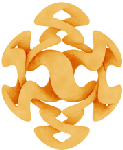
TANTRIC SYMBOLS
INTRODUCTION
For the untrained, especially the symbolism in tantra can be
extremely confusing. However, it should be noted that in modern
psychology, Freud and Jung have clarified many aspects of the sub-consciousness
in terms of symbolism. In Buddhism, something like sub-consciousness
is an impossibility by definition - an awareness without consciousness
does not make sense, but there are certainly areas of our mind we
are only barely aware of. In order to access these more hidden and
subtle aspects of our mind, symbols can be very effective in mind
transformation.
As Jean Shinoda Bolen writes in The
Tao of Psychology:
"Jung describes archetypes as 'patterns of instinctual
behaviour'. ... One definition of archetypes that Jung uses refers to
'primordial images', or archetypal figures that become activated and
then clothed with personally derived emotional coloration. This occurs
when an emotional [or spiritual] situation develops that corresponds
to a particular archetype. .. For example the 'Wise Old Man', the 'Divine
Child', 'All-Giving Mother', 'Patriarchal Father', 'Temptress' or 'Trickster'
- all are symbolic, recurring figures in dreams, literature and religions.
When the archetypal level of the collective unconscious is touched in
a situation, there is emotional intensity as well as a tendency for
symbolic expression. Then the usual everyday level of experience becomes
altered; there is more 'magic' in the air. One can become 'inspired'
or be on a 'crusade'."
|
The very last word of this quote is important in the entire
concept of tantra; it can be efficient in enhancing spiritual progress,
but if used unskilful, it can lead to madness like personal 'crusades'
and 'holy wars'. This presents another good reason for the traditional
secrecy of tantric practice and reliance on a true spiritual
master.
Another important aspect is the fact that the Buddha
clearly explained that "meaningless ritual" should not
be practised. So by definition, one could say that ritual in Buddhism
must be filled with (symbolic) meaning.
Most of below symbols are taken from the Tibetan
traditions, as they can be considered to have preserved the most
complete set of tantric teachings.
THE VAJRA
 The
Vajra is a very important symbol in Buddhist tantra. In fact,
the Tantra teachings are even referred to as the Vajrayana or Vajra-vehicle.
The vajra is probably a derivation of a weapon and a sceptre, and
may have its origins in the trident and a mendicants' staff, and
symbolises being indestructible, therefore sometimes compared to
a diamond. The
Vajra is a very important symbol in Buddhist tantra. In fact,
the Tantra teachings are even referred to as the Vajrayana or Vajra-vehicle.
The vajra is probably a derivation of a weapon and a sceptre, and
may have its origins in the trident and a mendicants' staff, and
symbolises being indestructible, therefore sometimes compared to
a diamond.
To give an impression of the vast symbolic meaning
of many objects used in Tibetan Buddhist tantra, below is a summary
excerpt from the excellent book "The
Encyclopedia of Tibetan Symbols and Motifs" by Robert
Beer.
"At the centre of the vajra is a flattened
sphere representing the dharmata as the 'sphere of actual reality'.
This sphere is sealed within by the syllable HUM, whose three
component sounds represent freedom from karma (Hetu), freedom
from conceptual thought (Uha) and the groundlessness of all dharmas
(M). On either side of the central hub are three rings [which]
symbolise the spontaneous bliss of Buddha nature as emptiness,
signlessness and effortlessness. Emerging from the three rings
on either side are two eight-petalled lotuses. The sixteen petals
represent the sixteen modes of emptiness. The upper lotus petals
also represent the eight bodhisattvas, and the eight lower
petals, the eight female consorts. Above the lotus bases are another
series of three pearl-like rings, which collectively represents
the six perfections of patience, generosity, discipline,
effort, meditation and wisdom. A full moon disc crowns each of
the lotuses, symbolising the full realisation of absolute and
relative bodhicitta Emerging from the moon discs are five
tapering prongs, forming a spherical cluster or cross. The four
[outer] curved prongs curve inwards to the central prong, symbolising
that the four aggregates of form, feeling, perception and
motivation depend upon the fifth aggregate of consciousness. The
five upper prongs of the vajra represent the Five Buddhas (Akshobhya,
Vairochana, Ratnasambhava, Amitabha and Amogasiddhi), and the
unity of their five wisdoms, attributes and qualities. The five
lower prongs represent the female consorts of the Five Buddhas
(Mamaki, Lochana, Vajradhatvishvari, Pandara and Tara) and the
unity of their qualities and attributes. 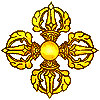 The
Five Buddhas and their consorts symbolise the elimination of the
five aggregates of personality. The ten prongs together symbolise
the ten perfections (the six mentioned above plus skilful
means, aspiration, inner strength, and pure awareness); the 'ten
grounds' or progressive levels of realisation of a bodhisattva;
and the ten directions. Each of the outer prongs arise
from the heads of Makaras (sea monster). The four Makaras symbolise
the four immeasurables (compassion, love, sympathetic joy
and equanimity); the four doors of liberation (emptiness, signlessness,
wishlessness and lack of composition); the conquest of the four
Maras (emotional defilements, passion, death, divine pride and
lust); the four activities or karmas; the four purified elements
(air, fire, water, earth); and the four joys (joy, supreme joy,
the joy of cessation and innate joy). The
Five Buddhas and their consorts symbolise the elimination of the
five aggregates of personality. The ten prongs together symbolise
the ten perfections (the six mentioned above plus skilful
means, aspiration, inner strength, and pure awareness); the 'ten
grounds' or progressive levels of realisation of a bodhisattva;
and the ten directions. Each of the outer prongs arise
from the heads of Makaras (sea monster). The four Makaras symbolise
the four immeasurables (compassion, love, sympathetic joy
and equanimity); the four doors of liberation (emptiness, signlessness,
wishlessness and lack of composition); the conquest of the four
Maras (emotional defilements, passion, death, divine pride and
lust); the four activities or karmas; the four purified elements
(air, fire, water, earth); and the four joys (joy, supreme joy,
the joy of cessation and innate joy).
The tips at the end of the central prong may be shaped like a
tapering pyramid or four-faceted jewel, which represents Mount
Meru as the axial centre of both the outer macrocosm and inner
microcosm. The twin faces of the symmetrical vajra represent the
unity of relative and absolute truth."
The above describes the most common version of the five-pronged
vajra. There are also the one-pronged, three-pronged and nine-pronged
vajra, the double vajra (see left) etc., each with their own extensive
symbolism....
^Top of Page
THE BELL
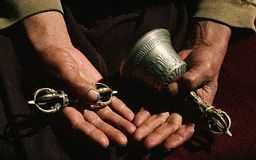 In
tantric rituals, the Vajra is normally held in the right
hand, and the Bell in the left. In this combination, the
Vajra symbolises method, bliss and male aspects, and the Bell symbolises
wisdom, emptiness, the female aspect. The bell as a whole symbolises
the sound of the Dharma and is often used in tantric rituals to
offer sound. In
tantric rituals, the Vajra is normally held in the right
hand, and the Bell in the left. In this combination, the
Vajra symbolises method, bliss and male aspects, and the Bell symbolises
wisdom, emptiness, the female aspect. The bell as a whole symbolises
the sound of the Dharma and is often used in tantric rituals to
offer sound.
The Bell is traditionally topped by a half-vajra (the 5 spokes
are the five forms of mystical wisdom), and below is the face of
Viarocana - the incarnation of universal truth (Dharma). On the
shoulder of the bell are 8 lotus petals with syllables in them;
the lotus leaves represent the 8 great Bodhisattvas and the syllables
are their consorts. As you may suspect by now, each and every detail
of the bell has an elaborate symbolic meaning. The whole of the
bell can even symbolise a complete mandala.
Whenever one holds these objects, one should try to remember these
symbolic meanings and gradually familiarise the mind with the idea;
this is the main idea behind meditation.
SOME OTHER TANTRIC IMPLEMENTS
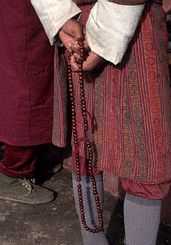 |
An implement carried around by most Tibetans is the Mala
or a rosary of prayer beads. These are not
unlike the Christian rosary, or the beads used in Islam
and Hinduism. They are used to focus ones' mind on the
recitation of mantras, and to count them as part of a
practice.
The story of the beads' origin is as follows: “Sakyamuni,
the founder of Buddhism, paid a visit to king Vaidunya…Sakya
directed him to thread 108 seeds of the Bodhi tree on
a string, and while passing them between his fingers to
repeat… ‘Hail to the Buddha, the law, and
the congregation’… (2,000) times a day (Dubin)”
(from this
page not all the info here is correct though).
There are for example practices for which one is required
to recite 100,000 mantras; obviously a simple counter
is needed to keep track of this huge number. The Tibetan
mala usually has at least 108 beads - this number probably
originates to the 108 names for Hindu deities (incidentally,
the same number is used in Islam to refer to God). See
also an interesting Hindu article on the number
of 108.
Tibetans often attach strings to their malas which have
little sliding rings on them, these are to keep count
of the number of malas; in such a way one can count up
to 10,000 or even more on one mala.
(The word 'rosary,' which has obvious similarities to
the mala, is said to have come from 'japa mala.' When
Roman explorers came into India and encountered the mala,
they heard 'jap mala' instead of 'japa mala.' 'Jap' means
'rose,' and the mala was carried back to the Roman Empire
as 'rosarium,' and into English as 'rosary.')
See here for an interesting
page on the Mala. And What
Not to Do with a Mala. You can even download
a Mala Manual here in PDF format.
Some exceptional
malas are made by a friend of mine.
|
|
A very special object within Tibetan
tantric practice is the Kapala or skullcup. The skullcup
is related to detachment and transformation of the world
we experience. |
|
Often used in Tibet are the small
handdrum (dhamaru) and the larger Chod-drum
(see right). These are double drums with strings
that holds small 'beads'. When one rotates the drum back
and forth, the beads tap on the drum. |
|
Swords, like the one of Buddha
Manjushri, symbolise the ability to cut through delusions
or obstacles, and as such they represent wisdom, knowledge,
or the protection given by Buddhist doctrine. On the image
at the left, it stands on the text of the Heart Sutra, a
crucial teaching on emptiness in the Mahayana tradition,
cutting through ignorance. |
| |
The Kartika (Skt.)
or curved knife symbolises the cutting of conventional wisdom
by the ultimate insight into emptiness. Is is usually present
as a pair, together with the skullcup, filled with wisdom
nectar. On a more simple level, the skull is a reminder
of (our) impermanence. Between the knife and the handle
is a makara-head, a mythical monster. |
| |
..The Khatvanga (Skt.)
could be called a magic wand or magicians' stick and represents
the 'magic powers' or siddhis (Skt.) of an accomplished
tantric practitioner.
From www.aroter.org:
"The shaft of the khatvangha has
eight sides which represent the Noble Eightfold path (the
fourth Noble Truth) and the eight classes of protectors.
At the end of the shaft is a dorje representing totality
and completion. Along the shaft of the khatvangha are
crossed dorjes, a gTérbum and three heads. The
crossed dorjes are symbolic of the indestructibility of
beginningless wisdom mind. The gTérbum is symbolic
of wealth and enrichment. The three heads – one
freshly severed, one rotting and one a skull – are
the symbols of the three spheres of being, chö-ku,
long-ku and trül-ku [Nirmanakaya, the middle one
represents the Sambhogakaya, and the top one is a skull,
representing the Dharmakaya] which are unified by the
shaft of the khatvangha demonstrating their inseparability.
Streamers of the colours of the five elements hang from
the khatvangha, as well as a bell and dorje which represent
emptiness and form. At the top of the khatvangha are the
three prongs which pierce the fabric of attraction, aversion
and indifference. Hanging from the prongs are two pairs
of rings. These signify the four philosophical extremes
that are denied by Dharma: eternalism and nihilism, monism
and dualism. Finally the khatvangha is surmounted by wisdom
fire – the fire that burns self-protection, justification
and referentiality."
The top of the kathvanga can be formed
by a vajra or a trident (often depicted with flames around
it) |
|
The hook (ankusa in
Skt.) is a tool which was originally used to ride elephants.
In Buddhism, it is considered a hook with which one can
draw people in doubt to the teachings. |
|
A wrathful implement like the Phurba
(Tib.) or ritual dagger is used to subdue and subsequently
enlist negative, uncontrolled forces in a wrathful manner. The
cutting end has three sides, rather than a normal dagger.
Above the cutting end is a makara-head (a mythical monster)and
at the top is the handle, made of three heads of wrathful
protectors. Phurbas refer to the Buddhist theme of self-control,
and to the tantric transformation of negative powers on
the path to enlightenment. |
The Tibetan Bumpa is a ritual vase which
represents the palace of the deities. It is used as a vessel of
purification, to bestow blessings and confer empowerments. There
are also Treasure
Vases, which contain special substances and are buried or hidden
for various purposes.
Mallets or Hammers (Skt. mudgara)
and a Club (Skt. gada) symbolise crushing strength or power.
Bow and Arrow refer to single pointed concentration to achieve
the goal of liberation.
The Trident is a piercing weapon, its, three
points also carrying connotations of the power of the three jewels.
An Arrow with ribbons around it can symbolize longevity
and prosperity.
The Lasso relates to the constraint of negative forces.
A Trident symbolizes the attainment of the three Kayas (or
Buddha bodies).
^Top of Page
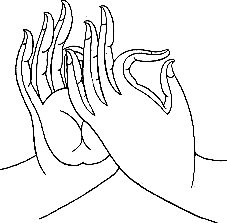 MUDRAS
- SACRED GESTURES MUDRAS
- SACRED GESTURES
To make the tantric experience complete, actions
of one's body, speech and mind are to be transformed. A typical
example of the actions of the body is the practice of mudras. These
are movements and positions of the hands which have profound symbolic
meaning. One uses mudras to symbolise for example the various offerings,
but they also convey general meanings like e.g. teaching or meditation.
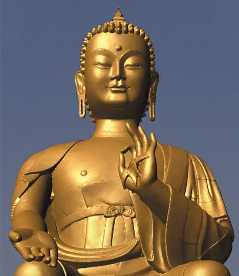 The
image on the left is a virtual image of the planned Maitreya statue
in Bodhgaya. It happens to be an unconventional posture to depict
Maitreya: his right hand on the knee signifies giving refuge and
loving compassion to all beings; the left hand at his heart is in
the teaching (Dharmachakra) mudra: the thumb and index finger are
pressed together to symbolise the united practice of method and
wisdom, and the three remaining fingers are raised to symbolise
the Three Jewels of Refuge - Buddha, Dharma and Sangha. To the right
is an image of the teaching mudra when performed with both hands The
image on the left is a virtual image of the planned Maitreya statue
in Bodhgaya. It happens to be an unconventional posture to depict
Maitreya: his right hand on the knee signifies giving refuge and
loving compassion to all beings; the left hand at his heart is in
the teaching (Dharmachakra) mudra: the thumb and index finger are
pressed together to symbolise the united practice of method and
wisdom, and the three remaining fingers are raised to symbolise
the Three Jewels of Refuge - Buddha, Dharma and Sangha. To the right
is an image of the teaching mudra when performed with both hands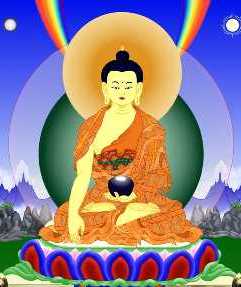
The image on the right represents a traditional
depiction of Shakyamuni Buddha, just after his enlightenment. His
right hand touches the earth to symbolise it has witnessed his enlightenment
(bhumisparsha mudra), and his left hand is in the meditation mudra.
Sometimes the meditation mudra is performed with both hands on top
of each other in the lap as the image below shows.

MANDALAS - SACRED CIRCLES
 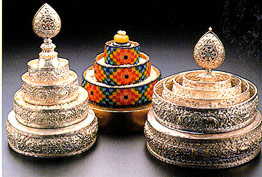 In
Tibetan Buddhism, Mandalas come in two varieties; it can represent
the universe (see the image left), as it is used in the Mandala
Offering Ritual, where one symbolically offers the entire universe.
For this, several rings can be placed on top of each other filled
with rice and precious objects (see right). During the offering
one recites mandala
offering prayers. In the center of the mandala is Mount Meru,
the central axis in the Buddhist (and Jain) cosmos. In
Tibetan Buddhism, Mandalas come in two varieties; it can represent
the universe (see the image left), as it is used in the Mandala
Offering Ritual, where one symbolically offers the entire universe.
For this, several rings can be placed on top of each other filled
with rice and precious objects (see right). During the offering
one recites mandala
offering prayers. In the center of the mandala is Mount Meru,
the central axis in the Buddhist (and Jain) cosmos.
The best-known mandalas are part of the world of
Tantra; they represent the "3D Palace" of a specific meditation-Buddha
or deity. In the Tibetan tradition, they come as thangkas (scroll-paintings),
wall paintings, sand-drawings and 3D models of e.g. wood or metal.
A mandala can be "read" and studied like
a text and most important, be used for tantric meditation. The purpose
of a mandala is to acquaint the student with the tantra, and thus
allowing the student to identify with the deity and its sacred surroundings
as the mandala. (See also Tantra.)
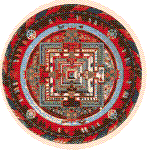 The
mandala of Kalachakra like the one on the left, symbolises the
entire universe in terms of planets and time cycles, as well as
aspects of our body and mind, and even the practice. Deities and
other images within the mandala represent for example the sense
organs, the elements and mental aspects, all in a purified state.
Every implement held by each deity has again its own meaning. The
mandala of Kalachakra like the one on the left, symbolises the
entire universe in terms of planets and time cycles, as well as
aspects of our body and mind, and even the practice. Deities and
other images within the mandala represent for example the sense
organs, the elements and mental aspects, all in a purified state.
Every implement held by each deity has again its own meaning.
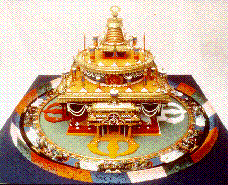 A
sand mandala represents a full 3 dimensional palace, often with
more than one storey. For example, the image on the right is from
an actual 3D mandala of Zhi-Khro (the six bardos) with 2 stories.
These mandalas are used in many ways; as a focal point of intense
meditation, in the practice of actually making one, and in their
destruction (like sand mandalas after an initiation is completed)
to teach impermanence. In the practice of Kalachakra, one strives
at visualising the complete mandala, including its hundreds of deities
in perfect detail within the size of a tiny drop. This should give
an idea of the level of concentration required for transforming
oneself into a Buddha.... Creating a Kalachakra mandala of some
2 meters diameter, traditionally takes 6 days, employing as many
as 16 monks. A
sand mandala represents a full 3 dimensional palace, often with
more than one storey. For example, the image on the right is from
an actual 3D mandala of Zhi-Khro (the six bardos) with 2 stories.
These mandalas are used in many ways; as a focal point of intense
meditation, in the practice of actually making one, and in their
destruction (like sand mandalas after an initiation is completed)
to teach impermanence. In the practice of Kalachakra, one strives
at visualising the complete mandala, including its hundreds of deities
in perfect detail within the size of a tiny drop. This should give
an idea of the level of concentration required for transforming
oneself into a Buddha.... Creating a Kalachakra mandala of some
2 meters diameter, traditionally takes 6 days, employing as many
as 16 monks.
For a nice description of the Chenresig mandala, see this description
by ven. Tenzin Deshek.
^Top of Page
OFFERING RITUALS
Offering rituals come in many different forms,
from placing offering cakes (Tib. torma) on an altar, to blessings
of sacred objects (Tib. rabne), dance rituals, feast-offerings (Tib.
tsog) and fire-pujas, to name but a few.
Offering Cakes or Tormas (Tib.)
contain several substances with their own symbolic meaning. In India,
this offering traditionally contained three sweet substances: molasses,
honey and sugar and three white substances: curd, butter and milk.
In Tibet, these would be mixed with tsampa or parched barley flour
to make an offering cake. For specific practices, grains, alcohol,
meat, or medicine may be added. 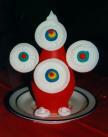 Adding
five types of grains is believed to overcome poverty and famine,
while the 6 medicinal aromatics are thought to overcome illness
and epidemics. Tormas can have many different shapes, again related
to their specific purpose. For example, typical stepped, pyramid
shaped tormas are specific to wrathful deities with wavy outer lines
representing smoke and flames. The colour of these sometimes match
the colour of the attending deity. Cakes for peaceful deities often
contain round shapes. The tormas are traditionally decorated with
sculptures made of butter and colorants. For some occasions, a cross
of coloured threads, believed to have been introduced by Guru Rinpoche,
is added to the torma. Two wooden sticks are bound together in the
shape of a cross on which coloured threads are woven to create a
cobweb-like structure. Adding
five types of grains is believed to overcome poverty and famine,
while the 6 medicinal aromatics are thought to overcome illness
and epidemics. Tormas can have many different shapes, again related
to their specific purpose. For example, typical stepped, pyramid
shaped tormas are specific to wrathful deities with wavy outer lines
representing smoke and flames. The colour of these sometimes match
the colour of the attending deity. Cakes for peaceful deities often
contain round shapes. The tormas are traditionally decorated with
sculptures made of butter and colorants. For some occasions, a cross
of coloured threads, believed to have been introduced by Guru Rinpoche,
is added to the torma. Two wooden sticks are bound together in the
shape of a cross on which coloured threads are woven to create a
cobweb-like structure.
Tormas can be vary from a simple small clump, to very large and
complicated, measuring up to a few meters in size. They can be used
as devices to which all the evil and sickness of an individual or
a community are transferred and thereby eliminated. Every year in
many of the temples, monasteries and dzongs the ritual of "casting
away the torma" is performed on the twenty-ninth day of the
last month of the year, in some places accompanied by dances. In
this way, negativities of the past year can be ended.
Feast Offerings: Tsog (Tib.) or Ganacakra
(Skt.) are regarded as an indispensable means for conferring accomplishment
and pacifying obstacles on the spiritual path. There are three aspects
to the feast-offering: the gathering of fortunate practitioners
in the feast; the outer, inner and secret sacraments of the ritual
which are offered and consumed during the feast; and Buddhas - whether
actual or visualised - who receive the offerings and bring the ritual
to its successful conclusion. The overall purpose is to distribute
merit and wisdom in the context of a specific tantric ritual.
Fire Pujas can be as simple as in the Vajra
Daka practice (see the page on tantra),
or can be very elaborate, like for purifying mistakes at the completion
of a long tantric retreat. Fire pujas are also held to bless the
ground before the construction of temples or stupas. Fire offerings
can be of different types: peaceful to overcome obstacles and defilements
(like usually after a retreat); increasing to expand wealth, wisdom
and merit and to gain longevity, controlling to subdue harmful forces;
forceful to banish negative forces.
^Top of Page
SOME OTHER RITUALS
Consecration. Upon completion of a temple
or an image for meditation, people invite lamas to perform a consecration
ceremony on an auspicious day fixed by an astrologer. The main purpose
of the consecration ritual is to invite the wisdom beings from their
pure Buddha-fields through the power of the practitioner's meditation,
the potency of the ritual and the devotion of the hosts. The wisdom
beings are invited, merge into the object being consecrated, and
their presence is sealed by the procedures of the ritual until the
object is damaged. Thus the object is blessed and becomes sacred.
A similar ritual, a deconsecration or transformation ritual, is
performed when a consecrated image has to be repaired or renovated.
A very interesting observation by Sakya Pandita in his book The
Right Practice of Different Views (Domsum Rabgye):
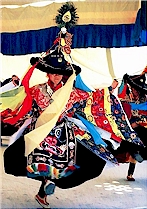
"Consecration of images is not taught
in the Sutras. However, if blessing ceremonies and offering
rituals on auspicious occasions, such as those performed
for a king at his enthronement are consecration rituals,
then one may say that consecration rituals are taught
therein."
|
Sacred Dances are carried out by monks for
various purposes; from rituals to remove obstacles prior to the
creation of a sand mandala ("protecting and consecrating the
site", in which interfering forces are summoned to protect
the mandala site) to offering dances and acting out the life stories
of famous Buddhist saints. Several monasteries are famed for their
annual sacred dances.
His Holiness the Dalai Lama is known however to have warned for
making these festivals too worldly; they are intended to be spiritual
practices, and should not be reduced to simple entertainment.
SYMBOLISM OF SOME DEITIES
In most of the mandalas of tantric Buddhaforms, the
5 Dhyani Buddhas are mentioned; some of the symbolism related to
them are found on the 5 Dhyani
Buddha page.
Each image of a tantric deity, including Shakyamuni
Buddha himself is filled with symbolism related to their specific
qualities, see for example Meditation
on 1000-arm Chenresig.
For extensive details on Kalachakra: do visit the International
Kalachakra Network website.
In Tibetan Buddhist monasteries, one can often
also find very aggressive-looking images, they are called the Protectors
or Guardians. Many - but not all - of them are manifestations of
fully enlightened Buddhas, but they appear in this wrathful form
to 'wake up' the meditator and for example direct this powerful
energy towards ones own problematic emotions like anger, attachment
and ignorance.
From The Crystal and the Way of Light: Sutra, Tantra and Dzogchen,
Teachings of Chogyal Namkhai Norbu, compiled and edited by John
Shane:
"Guardians of the teachings
There are eight principal classes of Guardians each with many
subdivisions. Some are highly realized beings, others not realized
at all. Every place - every continent, country, city, mountain,
river, lake or forest - has its particular dominant energy, or
Guardian, as have every year, hour and even minute: these are
not highly evolved energies. The various teachings all have energies
which have special relationships with them: these are more realized
Guardians. These energies are iconographically portrayed as they
were perceived when they manifested to masters who had contact
with them, and their awesome power is represented by their terrifyingly
ferocious forms, their many arms and heads, and their ornaments
of the charnel ground. As with all the figures in tantric iconography,
it is not correct to interpret the figures of the guardians as
merely symbolic, as some Western writers have been tempted to
do. Though the iconographic forms have been shaped by the perceptions
and culture of those who saw the original manifestation and by
the development of tradition, actual beings are represented."
VARIOUS OTHER SYMBOLS
The scorpion refers to negative
or harmful action (also menace or threat). It refers to transformation,
simply said, 'if the scorpion can be transformed then anyone, and
anything can be transformed.' Everyone and everything—is nothing
other than the energy of the non-dual state - and therefore the
power of every facet of existence can be harnessed through pure
vision as a means of attainment and compassionate activity.
LINKS
See also the image at the Kadarshan
Art page and the referred essay on the lasso.
An interesting collection of symbols and their explanation can be
found on the Khandro
website.
Tibetan Clipart which
you can use to illustrate anything and support an education project
for Tibetan youngsters.
A nice description and images of sacred
dances.
A lively description
the Mani Rimdu festival is found here on the web.
See here for more information on the web on consecration
and other rituals.
On tsog: see the Osel
Dorje Nyingpo website
Teachings on prayer flags and wheels can be found on the FPMT
website. Or view the Dharma
Haven site for much information.
Click for a large number of weblinks
to mandalas on the web.
Click for a screensaver
with prayer wheels.
 Just for
fun: Just for
fun:
Who are you going to believe, me or your own eyes?
Groucho Marx
Last
updated: February 6, 2011 |

 Just for
fun:
Just for
fun: The
Vajra is a very important symbol in Buddhist tantra. In fact,
the Tantra teachings are even referred to as the Vajrayana or Vajra-vehicle.
The vajra is probably a derivation of a weapon and a sceptre, and
may have its origins in the trident and a mendicants' staff, and
symbolises being indestructible, therefore sometimes compared to
a diamond.
The
Vajra is a very important symbol in Buddhist tantra. In fact,
the Tantra teachings are even referred to as the Vajrayana or Vajra-vehicle.
The vajra is probably a derivation of a weapon and a sceptre, and
may have its origins in the trident and a mendicants' staff, and
symbolises being indestructible, therefore sometimes compared to
a diamond.  The
Five Buddhas and their consorts symbolise the elimination of the
five aggregates of personality. The ten prongs together symbolise
the ten perfections (the six mentioned above plus skilful
means, aspiration, inner strength, and pure awareness); the 'ten
grounds' or progressive levels of realisation of a bodhisattva;
and the ten directions. Each of the outer prongs arise
from the heads of Makaras (sea monster). The four Makaras symbolise
the four immeasurables (compassion, love, sympathetic joy
and equanimity); the four doors of liberation (emptiness, signlessness,
wishlessness and lack of composition); the conquest of the four
Maras (emotional defilements, passion, death, divine pride and
lust); the four activities or karmas; the four purified elements
(air, fire, water, earth); and the four joys (joy, supreme joy,
the joy of cessation and innate joy).
The
Five Buddhas and their consorts symbolise the elimination of the
five aggregates of personality. The ten prongs together symbolise
the ten perfections (the six mentioned above plus skilful
means, aspiration, inner strength, and pure awareness); the 'ten
grounds' or progressive levels of realisation of a bodhisattva;
and the ten directions. Each of the outer prongs arise
from the heads of Makaras (sea monster). The four Makaras symbolise
the four immeasurables (compassion, love, sympathetic joy
and equanimity); the four doors of liberation (emptiness, signlessness,
wishlessness and lack of composition); the conquest of the four
Maras (emotional defilements, passion, death, divine pride and
lust); the four activities or karmas; the four purified elements
(air, fire, water, earth); and the four joys (joy, supreme joy,
the joy of cessation and innate joy). In
tantric rituals, the Vajra is normally held in the right
hand, and the Bell in the left. In this combination, the
Vajra symbolises method, bliss and male aspects, and the Bell symbolises
wisdom, emptiness, the female aspect. The bell as a whole symbolises
the sound of the Dharma and is often used in tantric rituals to
offer sound.
In
tantric rituals, the Vajra is normally held in the right
hand, and the Bell in the left. In this combination, the
Vajra symbolises method, bliss and male aspects, and the Bell symbolises
wisdom, emptiness, the female aspect. The bell as a whole symbolises
the sound of the Dharma and is often used in tantric rituals to
offer sound. 
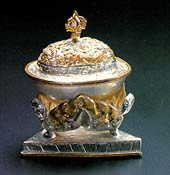
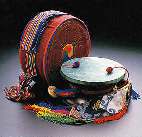

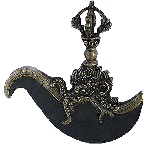

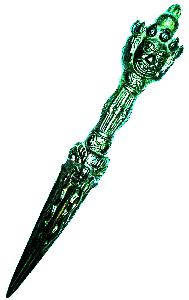







 A
sand mandala represents a full 3 dimensional palace, often with
more than one storey. For example, the image on the right is from
an actual 3D mandala of Zhi-Khro (the six bardos) with 2 stories.
These mandalas are used in many ways; as a focal point of intense
meditation, in the practice of actually making one, and in their
destruction (like sand mandalas after an initiation is completed)
to teach impermanence. In the practice of Kalachakra, one strives
at visualising the complete mandala, including its hundreds of deities
in perfect detail within the size of a tiny drop. This should give
an idea of the level of concentration required for transforming
oneself into a Buddha.... Creating a Kalachakra mandala of some
2 meters diameter, traditionally takes 6 days, employing as many
as 16 monks.
A
sand mandala represents a full 3 dimensional palace, often with
more than one storey. For example, the image on the right is from
an actual 3D mandala of Zhi-Khro (the six bardos) with 2 stories.
These mandalas are used in many ways; as a focal point of intense
meditation, in the practice of actually making one, and in their
destruction (like sand mandalas after an initiation is completed)
to teach impermanence. In the practice of Kalachakra, one strives
at visualising the complete mandala, including its hundreds of deities
in perfect detail within the size of a tiny drop. This should give
an idea of the level of concentration required for transforming
oneself into a Buddha.... Creating a Kalachakra mandala of some
2 meters diameter, traditionally takes 6 days, employing as many
as 16 monks.  Adding
five types of grains is believed to overcome poverty and famine,
while the 6 medicinal aromatics are thought to overcome illness
and epidemics. Tormas can have many different shapes, again related
to their specific purpose. For example, typical stepped, pyramid
shaped tormas are specific to wrathful deities with wavy outer lines
representing smoke and flames. The colour of these sometimes match
the colour of the attending deity. Cakes for peaceful deities often
contain round shapes. The tormas are traditionally decorated with
sculptures made of butter and colorants. For some occasions, a cross
of coloured threads, believed to have been introduced by Guru Rinpoche,
is added to the torma. Two wooden sticks are bound together in the
shape of a cross on which coloured threads are woven to create a
cobweb-like structure.
Adding
five types of grains is believed to overcome poverty and famine,
while the 6 medicinal aromatics are thought to overcome illness
and epidemics. Tormas can have many different shapes, again related
to their specific purpose. For example, typical stepped, pyramid
shaped tormas are specific to wrathful deities with wavy outer lines
representing smoke and flames. The colour of these sometimes match
the colour of the attending deity. Cakes for peaceful deities often
contain round shapes. The tormas are traditionally decorated with
sculptures made of butter and colorants. For some occasions, a cross
of coloured threads, believed to have been introduced by Guru Rinpoche,
is added to the torma. Two wooden sticks are bound together in the
shape of a cross on which coloured threads are woven to create a
cobweb-like structure. 